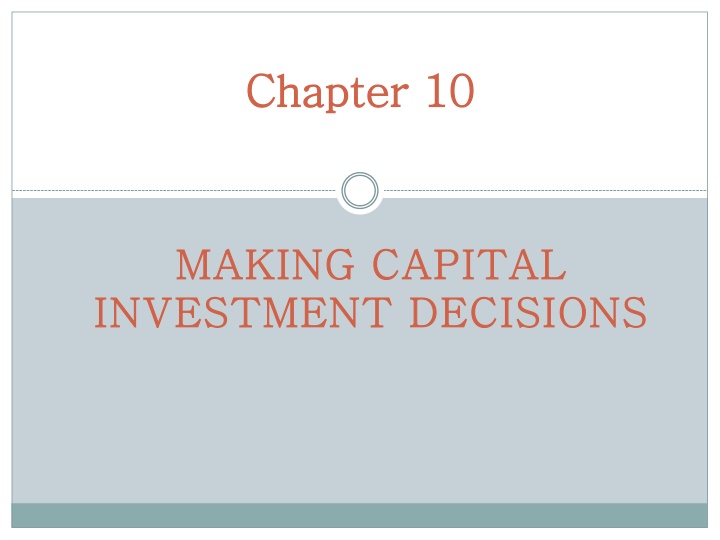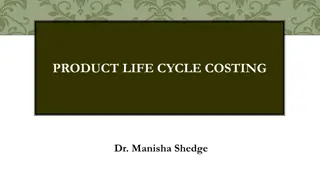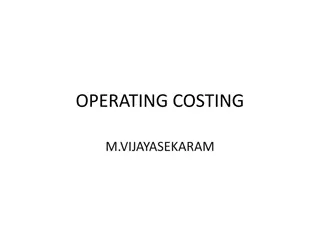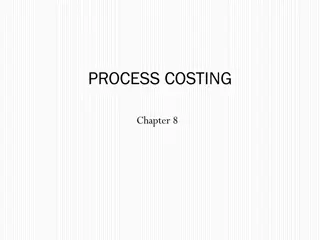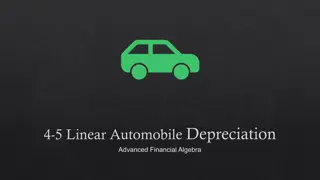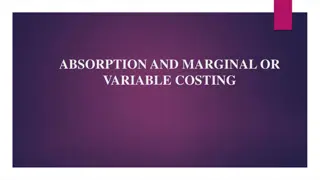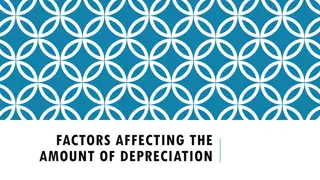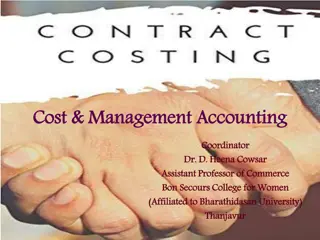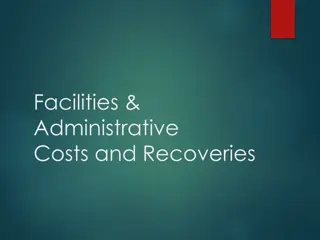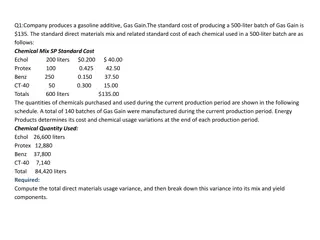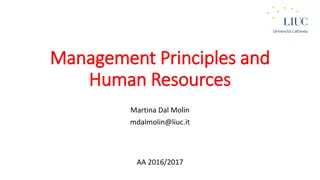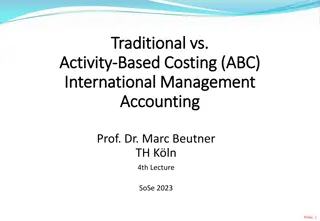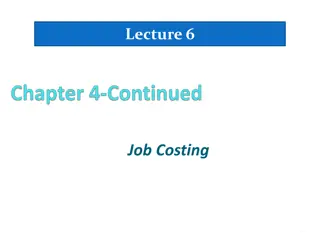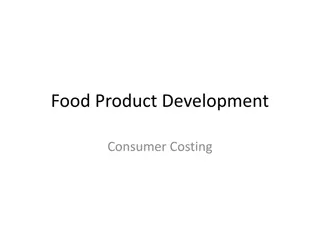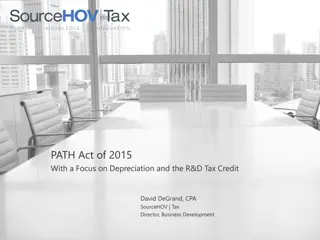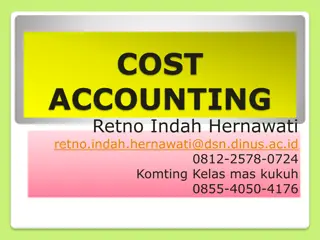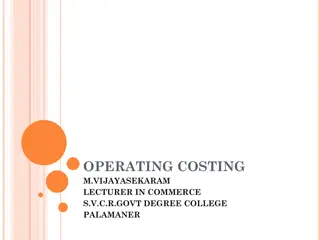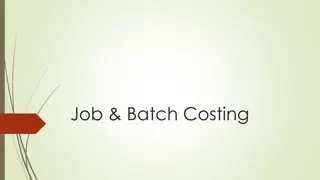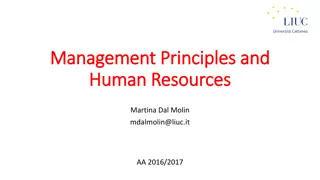Industrial Costing: Types of Costs and Depreciation Methods
In this lecture, you will explore different types of costs in industrial costing, including personnel costs and imputed costs. The differentiation of costs and kinds of depreciation will be discussed, covering depreciation methods and calculation of depreciation amounts. An example of imputed linear depreciation will illustrate how to determine annual depreciation.
Download Presentation

Please find below an Image/Link to download the presentation.
The content on the website is provided AS IS for your information and personal use only. It may not be sold, licensed, or shared on other websites without obtaining consent from the author.If you encounter any issues during the download, it is possible that the publisher has removed the file from their server.
You are allowed to download the files provided on this website for personal or commercial use, subject to the condition that they are used lawfully. All files are the property of their respective owners.
The content on the website is provided AS IS for your information and personal use only. It may not be sold, licensed, or shared on other websites without obtaining consent from the author.
E N D
Presentation Transcript
Chapter Chapter 10 10 MAKING CAPITAL MAKING CAPITAL INVESTMENT DECISIONS INVESTMENT DECISIONS
Relevant Cash Flows A change in the firm s overall future cash flow that comes about as a direct consequence of the decision to take that project. These cash flows are called incremental cash flows Incremental cash flows: the difference between a firm s future cash flows with a project and those without the project Irrelevant cash flows
The stand-alone principle The stand-alone principle allows us to analyze each project in isolation from the firm simply by focusing on incremental cash flows
Asking the Right Question You should always ask yourself Will this cash flow occur ONLY if we accept the project? If the answer is yes, it should be included in the analysis because it is incremental If the answer is no, it should not be included in the analysis because it will occur anyway If the answer is part of it, then we should include the part that occurs because of the project
Common Types of Cash Flows Sunk cost: a cost that has already been incurred and can t be removed. Opportunity cost: the cost of giving up a valuable alternative if a particular investment is undertaken. Side effects: a) negative impact on the cash flows of an existing product from the introduction of a new product (erosion) b) Positive impact
Common Types of Cash Flows Net working capital: Financing costs:
Notes Financial manager is interested in: Cash flows 1. 2. When these cash flows actually occurs 3. After-tax cash flows Note that Incremental cash flows are after-tax cash flows Differentiate between: after-tax cash flows, accounting profit and net income
Pro Forma Statements and Cash Flow Financial statements projecting future years operations Capital budgeting relies heavily on pro forma accounting statements, particularly income statements Computing cash flows refresher Operating Cash Flow (OCF) = EBIT + depreciation taxes OCF = Net income + depreciation (when there is no interest expense) Cash Flow From Assets (CFFA) = OCF net capital spending (NCS) changes in NWC
Example If Pepsi can sell 50,000 cans per year of a new product line for 4$ per can. It costs 2.5$ per can, this product line has three- year life with a required rate of return of 20%. There will be 12,000$ fixed costs per year, Pepsi will need to invest a total of 90,000$ in manufacturing equipment which will be 100 percent depreciated. In addition the project will require an initial 20,000$ investment in networking capital, and the tax rate is 34 percent Prepare a pro forma income statement Calculate the total investment for each year Calculate the total project cash flows Calculate the NPV
Ex 1 Page 327 Parker & stone Inc., is looking at setting up a new manufacturing plant in south park to produce garden tools. The company bought some land six years ago for 6$ million in anticipation of using it as a warehouse and distribution site, but the company has since decided to rent these facilities from a competitor instead. If the land were sold today, the company would net 6.4$ million. The company wants to build its manufacturing plant on this land; the plant will cost 14.2$ million to build, and the site requires 890,000$ worth of grading before its suitable for construction. What is the proper cash flow amount to use as the initial investment in fixed assets when evaluating the project? Why?
Ex 3 Page 328 A proposed new investment has projected sales of 830,000$. Variable costs are 60 percent of sales, and fixed costs are 181,000$; depreciation is 77,000$. Prepare a pro forma income statement assuming a tax rate of 35 percent. What is the projected net income?
Ex 4 Page 328 Consider the following income statement: sales costs 824,500 538,900 126,500 ? ? ? Depreciation EBIT Taxes(34%) Net income Fill in the missing numbers and then calculate the OCF. What is the depreciation tax shield?
Ex 9,10 Page 328 Summer Tyme, Inc., is considering a new three-year expansion project that requires an initial fixed asst investment of 3.9$ million. That fixed asset will be depreciated straight-line to zero over the three-year tax life. After which time it will be worthless. the project is estimated to generate 2,650,000$ in annual sales, with the cost of 840,000$. If the tax rate is 35 percent, what is the OCF for this project? Suppose that the required rate of return is 12 percent, what is the NPV?
More on NWC Why do we have to consider changes in NWC separately? GAAP requires that sales be recorded on the income statement when made, not when cash is received GAAP also requires that we record cost of goods sold when the GAAP also requires that we record cost of goods sold when the corresponding sales are made, regardless of when we actually pay our suppliers Finally, we have to buy inventory to support sales, although we haven t collected cash yet
Example Suppose that during a particular year of a project we have the following simplified income statement Sales 500 Costs 310 190 Net income Depreciation and taxes are zero, no fixed assets are purchased during the year. Also assume that the only components of networking capital are account receivables and payable. The beginning and ending amount for these accounts are as follows Beginning of year 880 550 330 Ending of year 910 605 305 change 30 55 -25 AR AP NWC
Depreciation Depreciation itself is a non-cash expense; consequently, it is only relevant because it affects taxes Depreciation tax shield = DT D = depreciation expense T = marginal tax rate
Computing Depreciation Straight-line depreciation D = (Initial cost salvage) / number of years Very few assets are depreciated straight-line for tax purposes MACRS Need to know which asset class is appropriate for tax purposes Multiply percentage given in table by the initial cost
Example Consider an automobile costing 12,000$. What is the depreciation using the MACRS method? class examples Three-year Equipments used in research Five-year Autos, computers Seven-year Most industrial industries Property class year Three-year Five-year Seven-year 1 33.33% 20.00% 14.29% 2 44.45 32 24.49 3 14.81 19.20 17.49 4 7.41 11.52 12.49 5 11.52 8.93 6 5.76 8.92 7 8.93 8 4.46
After-tax Salvage If the salvage value is different from the book value of the asset, then there is a tax effect Book value = initial cost accumulated depreciation After-tax salvage = salvage T(salvage book value)
MARCS Book values Year Beginning book value depreciation Ending book value 9,600 5760 3456 2073.6 691.2 0 1 2 3 4 5 6 12,000 9600 5760 3456 2.73.6 691.2 12000*.2=2400 12000*.32=3840 12000*.192=2304 12000*.1152=1382.4 12000*.1152=1382.4 12000*.0576=691.2
Example: Depreciation and After-tax Salvage You purchase equipment for $100,000, and it costs $10,000 to have it delivered and installed. Based on past information, you believe that you can sell the equipment for $17,000 when you are done with it in 6 years. The company s marginal tax rate is 40%. What is the depreciation expense each year and the after-tax salvage in year 6 for each of the following situations? Suppose the appropriate depreciation schedule is straight-line What is the depreciation using the MACRS method (three years)? What is the end-year book value? What is the after-tax salvage? What is the depreciation using the MACRS method (seven years)? What is the end-year book value? What is the after-tax salvage?
Ex 6 Page 328 A piece of newly purchased industrial equipment costs 1,080,000$ and its classified as seven-year property under MARCS. Calculate the annual depreciation allowance and end-of-the year book values for this equipment
Book value versus Market value The book value of an asset can differ substantially from its actual market value The difference between book and market value will affect taxes
The Majestic Mulch and Compost Company (Example) the company is investigating the feasibility of a new line of power mulching tools. MMCC projects unit sales as follows: year 1 2 3 4 5 6 7 8 Unit sales 3,000 5,000 6,000 6,500 6,000 5,000 4,000 3,000
The Majestic Mulch and Compost Company (Example) The new Mulcher will sell for 120$ per unit to start. After three years MMCC anticipates that the price will drop to 110$ due to competition. The company will require 20,000$ networking capital at the start. After that the networking capital will be about 15 percent of sales for that year. The variable cost per unit is 60$, and the total fixed costs are 25,000$ per year. It will cost about 800,000$ to buy the equipment and it will be worth about 20 percent of its cost in eight years. The relevant tax rate is 34 percent ant the required return is 15 percent. Based on this information, should MMCC proceed?
The Majestic Mulch and Compost Company (Example) Calculation of sales = unit price * number of units year 1 2 3 4 5 6 7 8 Unit price 120$ 120 120 110 110 110 110 110 Unit sales 3,000 5,000 6,000 6,500 6,000 5,000 4,000 3,000 Revenues 360,000$ 600,000 720,000 715,000 660,000 550,000 440,000 330,000
The Majestic Mulch and Compost Company (Example) Calculation of depreciation= MARCS percentage * initial cost year 1 2 3 4 5 6 7 8 MARCS percentage depreciation 114,320 195,920 139,920 99,920 71,440 71,360 71,440 35,680 Ending book value 685,680 489,760 349,840 249,920 178,480 107,120 35,680 0 14.29% 24.49 17.49 12.49 8.93 8.92 8.93 4.46
The Majestic Mulch and Compost Company (Example) year 1 2 3 4 5 6 7 8 revenues 36,000 600,000 720,000 715,000 660,000 550,000 440,000 330,000 VC 180,000 300,000 360,000 390,000 360,000 300,000 240,000 180,000 FC 25,000 25,000 25,000 25,000 25,000 25,000 25,000 25,000 Dep 114,320 195,920 139,920 99,920 71,440 71,360 71,440 35,680 EBIT 40,680 79,080 195,080 200,080 203,560 153,640 103,560 89,320 Tax(34%) 13,831 26,887 66,327 68,027 69,210 52,238 35,210 30,369 NI 26,849 52,193 128,753 132,053 134,350 101,402 68,350 58,951
The Majestic Mulch and Compost Company (Example) Calculation of OCF = EBIT + Dep - Tax year 1 2 3 4 5 6 7 8 EBIT 40,680 79,080 195,080 200,080 203,560 153,640 103,560 89,320 Dep 114,320 195,920 139,920 99,920 71,440 71,360 71,440 35,680 Tax(34%) 13,831 26,887 66,327 68,027 69,210 52,238 35,210 30,369 OCF 141,169 248,113 268,673 231,973 205,790 172,762 139,790 94,631
The Majestic Mulch and Compost Company (Example) Calculation of NWC for each year= sales * 0.15 Change in NWC= ending NWC Beg NWC year 0 1 2 3 4 5 6 7 8 Revenues NWC 20,000 54000 90000 108000 107250 99000 82500 66000 49500 Cash flow -20000 -34000 -36000 -18000 750 8250 16500 16500 16500 360,000$ 600,000 720,000 715,000 660,000 550,000 440,000 330,000
The Majestic Mulch and Compost Company (Example) year 1 2 3 4 5 6 7 8 0 Initial NWC -20,000 Change in NWC -34000 -36000 -18000 750 8250 16500 16500 16500 NWC recovery 49500 Total change in NWC -20000 -34000 -36000 -18000 750 8250 16500 16500 66000
The Majestic Mulch and Compost Company (Example) Calculation of salvage = 0.2 * initial cost After-tax salvage = salvage T (salvage BV) year 0 1 2 3 4 5 6 7 8 Initial cost -800,000 After-tax salvage 105600 Capital spending -800000 105600
The Majestic Mulch and Compost Company (Example) year 0 1 2 3 4 5 6 7 8 Calculation of total CF= OCF change in NWC- NCS 268673 248113 141,169 OCF 231973 205790 172762 139790 94631 -20000 -34000 -36000 -18000 750 8250 16500 16500 66000 Change in NWC -800000 105600 NCS -820000 107169 212113 250673 232723 214040 189262 156290 266231 Total CF -820000 -712831 -500718 250045- -17322 196718 385980 542270 808501 Cumulat ive CF -820000 107169/*1 .15= 93190 212113/1. 15^2= 160388 164822 133060 106416 81823 58755 87031 Discoun t cash flow @15% NPV
Other Methods for Computing OCF If you have the following information: Sales = 1,500$ Costs = 700$ Depreciation = 600$ Tax rate = 34% No interest Calculate the OCF
Other Methods for Computing OCF Bottom-Up Approach Works only when there is no interest expense OCF = NI + depreciation Top-Down Approach OCF = Sales Costs Taxes Don t subtract non-cash deductions Tax Shield Approach OCF = (Sales Costs)(1 T) + Depreciation*T
Depreciation tax shield The tax saving that results from the depreciation deduction Depreciation * tax rate
Ex 8 Page 328 An asset used in a four-year project falls in the five-year MARCS class for tax purpose. The asset has an acquisition cost of 7,900,000$ and will be sold for 1,400,000$ at the end of the project. If the tax rate is 35 percent. What is the after tax salvage value of the asset?
Ex 32 Page 332 Aguilera Acoustics, Inc. (AAI), projects unit sales for a new seven-octave voice emulation implant as follows year 1 2 3 4 5 Unit sales 93,000 105,000 128,000 134,000 87,000
Ex 32 Page 332 Production of the implants will require 1,800,000$ in networking capital to start and additional networking capital investments each year equal to 15 percent of the projected sales increase for the following year. Total fixed costs are 1,200,000$ per year, variable production costs are 265$ per unit, and the units priced at 380$ each. The equipment needed to begin production has an installed cost of 24,000,000$.becasue the implants are intended for professional singers, this equipment is considered industrial machinery and thus qualified as seven-year MARCS property. In five years, this equipment can be sold about 20 percent of its acquisition cost.AAI is in the 35 percent marginal tax and has a required return on all its projects of 18 percent. Based on these estimates, what is the NPV?
